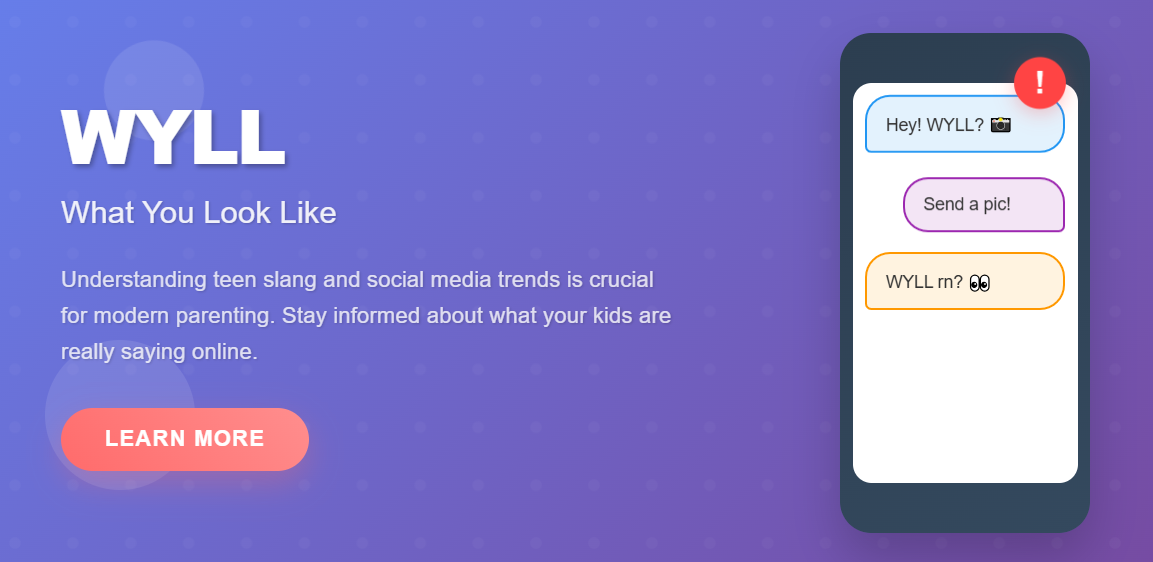In today's digital world, teenagers communicate using a language that can feel completely foreign to parents. One moment your teen is texting away on their phone, and the next, you're wondering what mysterious acronyms like "WYLL" slang actually mean. As social media platforms continue to shape how young people interact online, understanding these digital shortcuts has become essential for parents who want to stay connected with their children's online lives.

Part 1: What Does WYLL Mean?
WYLL stands for "What You Look Like?" – a casual abbreviation teenagers use to ask someone about their physical appearance or request a photo. This popular social media and texting abbreviation is typically used when someone wants to see a photo of the person they're communicating with online.
When teens use wyll meaning in chat, they're essentially asking for a visual confirmation of who they're talking to. The wyll meaning in text remains consistent across platforms – it's a shortened way of saying "show me what you look like" without typing the full question.
On wyll meaning text snapchat specifically, this term often appears in direct messages when teens add new contacts or reconnect with friends they haven't seen in a while. The wyll meaning slang has become so widespread that most of our citations for this abbreviation are from women who are annoyed by being asked this question, indicating its sometimes problematic nature.
The wyll in text meaning can vary slightly based on context:
- Between friends who haven't met in person yet
- When reconnecting with old classmates
- In online gaming communities where avatars are common
- During initial conversations on social platforms
According to wyll meaning urban dictionary and other sources, the assumption is that WYLL texting slang originated on social networks, probably Snapchat, where visual communication is the primary form of interaction.
Part 2: How Gen Z Uses WYLL Slang Today
Generation Z has transformed WYLL into more than just a simple question – it's become a digital icebreaker that reflects their visual-first communication style. A compelling 2023 linguistic research from the Digital Communication Institute revealed that Generation Z generates approximately 27 unique slang terms monthly, with WYLL representing a prime example of this rapid language evolution.
Today's teens use WYLL in various ways:
✅ Casual Conversations: "We've been chatting for weeks, WYLL?"
✅ Gaming Communities: "Cool gameplay! WYLL in real life?"
✅ Reconnecting: "Haven't seen you since middle school, WYLL now?"
✅ Group Chats: "New member joined! WYLL?"
The phrase "what does wyll mean in a text from a teenager" often depends on the relationship context. Depending on how long communication has been going on, this can be interpreted as extremely shallow or sheer human curiosity. Girls might use it differently than boys – Guys typically ask "WYLL" on Snap to see if they can get a photo sent to them, while girls often use it more casually among friends.
Platform-specific usage includes:
- Snapchat: Most common, often the first message after adding someone
- Instagram: Used in DMs when profiles lack photos
- TikTok: Appears in direct messages rather than public comments
- WhatsApp: More personal, typically between closer connections
In 2025, text shortcuts are constantly changing, and WYLL has evolved from a simple question to sometimes carrying deeper social implications about appearance-based judgments in digital spaces.
Part 3: How to Talk Slang with Your Kids
Starting conversations about online slang like WYLL doesn't have to feel awkward or forced – it's an opportunity to better understand your teen's digital world. As a parent, knowing these terms helps bridge the communication gap and shows your child you're making an effort to understand their language.
Here are effective approaches for discussing WYLL and similar slang:
🚨 Open with Curiosity, Not Criticism
- "I noticed 'WYLL' in your messages. Can you explain what it means to you?"
- "How do you feel when someone asks you WYLL online?"
- "What boundaries do you set when people ask for photos?"
⚠️ Address Safety Concerns
- The phrase "how do I respond to wyll" is something your teen should know how to handle safely:
- They have the right to decline sharing photos
- Encourage them to consider why someone is asking
- Discuss the permanence of shared images online
Remind them that it's completely up to you how you'll respond. If you feel uncomfortable for any reason, don't send anyone your photo
✅ Set Clear Guidelines
- Establish rules about sharing personal photos
- Discuss appropriate responses to WYLL requests
- Create an open-door policy for uncomfortable situations
- Consider using parental control apps like FamiSafe to monitor concerning interactions
Long-tail keywords parents often search include:
- "What to do when stranger asks teen WYLL"
- "Is WYLL dangerous for teenagers on Snapchat"
- "How to monitor teen responses to WYLL requests"
- "Teaching kids safe responses to appearance questions online"
Remember that technology can support your parenting efforts - tools like FamiSafe help you stay informed about potentially risky conversations without constantly looking over your teen's shoulder. When properly configured its Social Slang Detection feature, these apps can alert you to concerning patterns while still respecting your child's growing independence.
- Set Screen Time & App Rules
- Capture Instant or Scheduled Screenshots
- Web Filter & Safe Search
- Location Tracking & Driving Report
- App Blocker & App Activity Tracker
- YouTube History Monitor & Video Blocker
- Social Media Texts & Porn Images Alerts
- Available on Multiple Platforms
Conclusion
Understanding WYLL meaning and other teen slangs isn't just about decoding acronyms – it's about staying connected to your child's digital life and ensuring their online safety. While WYLL might seem like harmless shorthand for "What You Look Like," it represents the broader challenge of navigating appearance-based interactions in digital spaces. By learning what WYLL means and discussing it openly with your teens, you're taking an important step in guiding them through the complexities of online communication.


